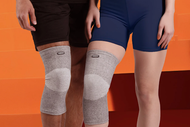Maintaining an active lifestyle requires effort and protection for your body's vulnerable parts, including your knees.
Maintaining an active lifestyle requires effort and protection for your body's vulnerable parts, including your knees.
Maintaining an active lifestyle requires effort and protection for your body's vulnerable parts, including your knees.
As you engage in activities like weightlifting or high-impact sports, knee support becomes more important. Knee wraps vs. sleeves is a hot topic when selecting the right gear.
This guide cuts through the confusion, providing clear insights on when to use each type of support to enhance your performance and minimize risks of knee injury.
Let’s get started.
Knee wraps are long, elastic strips of fabric that you wrap around your knees. In powerlifting, where maximal lifts are celebrated, knee wraps are almost as common as the weights.
Knee wraps create a cast-like effect and provide exceptional support, which can help with performing squats with heavy loads.
By storing elastic energy during the descent of a squat, knee wraps enable a rebound effect to assist lifters as they stand up, potentially increasing the amount that can be lifted.

This accessory is a common choice for activities requiring maximum support. You can wear knee wraps for heavy powerlifting, max-out sessions, or high-intensity strength training, where additional support and performance enhancement are sought.
Knee wraps, however, have a restrictive nature. They aren't suited for sports or workouts that involve a large degree of movement or agility, such as running, basketball, or varied CrossFit WODs (Workouts of the Day).
Unlike knee wraps, sleeves are more about protection than performance enhancement. Made from neoprene or similar materials, they slide over the knee and provide compression, supporting and warming the joint to reduce pain and swelling.
This compression is also beneficial for recovery, as it may also reduce the onset of muscle soreness after exercise.
Knee sleeves are incredibly versatile and are widely used across many activities. Wear knee sleeves if you’re into endurance sports, CrossFit, Olympic weightlifting, and general gym workouts.
Runners prefer knee sleeves for their protective benefits. Basketball players looking to safeguard against knee injuries and weightlifters who need support without the constriction of wraps also love them.
Knee sleeves are the go-to option for those requiring a functional balance of support and mobility.
Don’t miss our shopping guide for getting the best knee compression sleeves.
Knee wraps are usually made of a blend of cotton, rubber, and polyester, which allows them to stretch and provide the tight, snug fit required for heavy lifting.
Sleeves, by contrast, are commonly fashioned from neoprene, offering comfortable compression without the same level of tightness.
Knee wraps are all about maximal support. By tightly wrapping them around your knees, you can adjust the level of pressure to support your needs. Knee sleeves provide gentle compression at the knee joint which can aid in recovery by minimizing swelling and pain.
The tightness of knee wraps significantly restricts movement, making them less suitable for exercises requiring a full range of motion. Knee sleeves, however, allow for more freedom, making them a better option for dynamic movements.
Knee wraps can be helpful during exercises that put a lot of stress on the knees, such as heavy squats and leg presses. Sleeves are well-suited for activities where movement is key, like running, basketball, or Olympic lifting.
Do you play basketball? Check this guide on choosing the best braces and sleeves this 2024.
When selecting a knee wrap, it's important to weigh the advantages and drawbacks to determine if they're the right choice for your lifting routine.
Knee sleeves are popular among athletes, but as with any gear, they have positive and negative aspects.
When choosing between knee wraps and sleeves, fitness goals and personal comfort should be key priorities. If your workout includes a lot of heavy lifting and you want more support, knee wraps are the way to go.

Sleeves or knee straps are your best bet for those involved in activities requiring more movement or looking for recovery support.
Consider the type of exercises you most often engage in. Powerlifters often gravitate towards wraps for added support, while general fitness enthusiasts might prefer the versatility and comfort of sleeves.
Here are some specific exercise examples that will benefit wraps and sleeves:
Knee wraps and sleeves offer unique benefits tailored to different activities and preferences.
By understanding the differences and assessing your personal needs, you can make an informed decision to keep your knees supported, healthy, and ready to tackle whatever your workout throws.
Whether you go for wraps or sleeves, remember that the right protective gear is important for longevity in your fitness endeavors.
If you are looking for the highest quality recovery wear, Thermo Recovery Wear has got you covered!
Browse our collection and choose the perfect option for you!

Incrediwear is on...
September 25, 24

Pain management i...
September 23, 24

Recovery wear is ...
September 12, 24